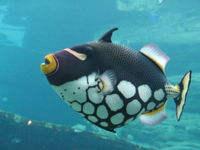Clown Triggerfish (Balistoides conspicillum)
From The Aquarium Wiki
Clown Triggerfish
Balistoides conspicillum
946 Litres (250 US G.)
38.1-50.8cm (15-20 ")
8.2 - 8.4
22.2-25.6°C (72 -78 °F)
8-12 °d
1:1 M:F
10-12 years
Family
Balistidae
This animal is available captive bred
Contents
Additional names
- Clown Triggerfish, Big-spotted Triggerfish, Clown Trigger
Additional scientific names
- Balistes conspicillum, Balistoides niger
Origin[edit]
- Indo-Pacific: East Africa south to Durban, South Africa and east through Indonesia to Samoa, north to southern Japan and south to New Caledonia.
Sexing[edit]
- It is virtually impossible to visually sex these fish.
Tank compatibility[edit]
- This is a large and aggressive fish and should only be housed with similar-tempered fish of the same size. It will eat most invertebrates and small fish and is best in a fish-only set up, not reef. It is best to keep only one Clown Trigger per tank. While small specimens can be housed in community tanks for a short amount of time, these specimens rarely adapt well to captivity.
Diet[edit]
- Feed this fish a mix of shrimp, mussels, squid, krill and clams. It requires hard-shelled food like some shrimp in order to wear down it's teeth.
Feeding regime[edit]
- Feed sparingly once or twice a day, these fish have a huge appetite.
Environment specifics[edit]
- Requires a very spacious tank with plenty of open swimming room. Décor must be very secure as this fish will rearrange its surroundings.
Behaviour[edit]
- An aggressive predator.
Identification[edit]
- An exceptionally distinctive fish. It is oval in shape with a prominent beak-like mouth and comparatively small fins. The top half of the body is brown with speckled yellow over the top of the body in front of the pointed dorsal. The dorsal can be raised when displaying or alarmed. The bottom half of the body and belly has large white spots, similar in pattern to that of a giraffe, with brown behind. There is a horizontal white band across the nose in front of the eyes and the beak is yellow. The base of the caudal is brown, the mid section yellow, and the end is banded again in brown.
Pictures[edit]
Videos[edit]
| Mating ritual in the wild: |
External links[edit]
- Fishbase (Mirrors:
 )
)



